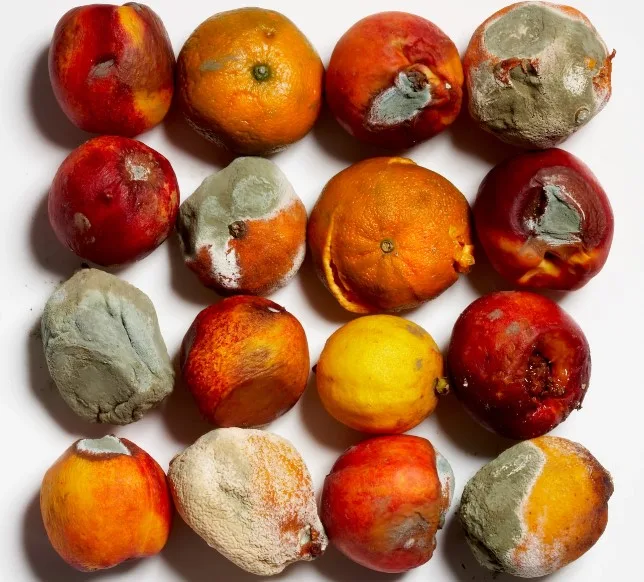What to do about moldy food? When do you scrape it off, when do you throw out the whole thing?
By Leah Worthington
So, you splurged on a carton of raspberries yesterday, and already they’re starting to look a little…fuzzy. But it would be such a waste to throw them out — maybe you can just pick out the moldy ones? Not so fast.
 As innocuous as a few dusty patches might seem, foodborne mold can cause a host of issues, from indigestion to — in the most extreme situations — kidney damage or even cancer.
As innocuous as a few dusty patches might seem, foodborne mold can cause a host of issues, from indigestion to — in the most extreme situations — kidney damage or even cancer.
Of course, not all mold is out to kill you. In fact, most mold you see on your food is harmless, but it’s nearly impossible to visually discern what’s safe from what could make you sick. And some foodborne mold may not be visible at all.
Still, a little household maintenance can go a long way — from kitchen sanitation to food storage. Here’s your expert guide to best household practices to extend your food life and protect your gut.
Science of mold
Mold is everywhere — on surfaces, in the air, in the soil. From the acidic brine of pickle juice to the grout between your bathroom tiles, mold can thrive in even the most inhospitable environments.

When should you scrape off the mold and when should you throw out the whole thing? It depends.
Although they can survive in less, molds are happiest in warm, humid, nutrient-rich environments, according to Elisabetta Lambertini, a senior research scientist at the Global Alliance for Improved Nutrition. Think of that steaming sourdough loaf or half-eaten apricot jam as an all-you-can-eat buffet for a hungry mold.
Because molds reproduce by releasing clouds of microscopic spores, they can travel anywhere accessible by wind or water. In fact, the average person inhales between 1,000 and 10 billion spores per day. With billions of spores floating around us, the only place foodborne mold won’t grow is unopened, airtight jarred or canned foods. However, there are some easy strategies to slow the inevitable growth process. For a quick rule of thumb, Lambertini refers to the core four practices for food safety: clean, separate, cook, and chill.
“Temperature is a big one,” says Don Schaffner, chair of the department of food science at Rutgers University. “Microorganisms are just little bags of chemical reactions, right? So by lowering the temperature, we just slow all of that down.”
Refrigerating or freezing certain foods, like bread or other baked goods, can maximize their shelf life. Be sure to keep your fridge around 35-38 degrees F, and avoid overfilling to allow for sufficient airflow, which removes moisture and prevents mold growth, Lambertini advises.
When possible, cover food to keep out airborne spores and store items, particularly those with high water content, separately, in clean, closed containers to prevent possible cross-contamination. Regularly cleaning your fridge, countertops, and sponges will also minimize build-up or spreading of mold colonies, she adds — common household products like vinegar or diluted bleach will do the trick.

You decide.
Of course, some foods are more mold-friendly than others — produce being a prime example. One easy way to minimize that pesky fruit- and vegetable-borne mold is to wash your produce only prior to consuming it.
“Because they’re so susceptible to getting moldy, you certainly want to rinse off berries before you eat them,” Schaffner says. But wash them right from the grocery store and you risk storing them with residual water.
Allium vegetables (like onion and garlic) are particularly prone to black mold, a soil fungus, according to University of Wisconsin-Madison mold geneticist Jae-Hyuk Yu. While black mold can be safely washed or cut off, he suggests storing onions and garlic in netted bags that allow plenty of ventilation. Keep them in the fridge for maximum mold prevention, he says.
What kinds of mold are common in the house?
There are thousands of different mold species, including a wide variety that might worm their way into your pantry.
Of these potential kitchen offenders, only some produce toxins. For instance, Yu says, Penicillium growth on apples and Aspergillus growth on grapes and coffee produce mycotoxins that, even from acute exposures, can cause poisoning or kidney damage. Consumption of high levels of aflatoxin, the most dangerous mycotoxin, can cause severe toxicity or — with prolonged exposure — even liver cancer.
Thankfully, Lambertini says, “These are generally not the type of molds that grow in your fridge.” In fact, the majority of molds growing visibly on food in the U.S. are completely harmless. The bad news: It’s nearly impossible to pick out the dangerous ones.
“Accurate mold identification requires microscopy observation and other laboratory techniques, and is best left to trained professionals,” Lambertini says. Better to assume they’re toxic.
Mold is not always visible to the naked eye. The fungus can grow deep into a food before ever producing the billions of spores that create that familiar greenish white fuzzy layer. Just because you can’t see it, doesn’t mean it’s not there.
Fortunately our taste buds can be more discerning than our eyes. Even if you didn’t spot anything wrong before you took a bite, Schaffner says a “funky” taste is a good indication that something’s not right.
What to do if you find mold on your food
What should you do if you notice a bit of unwanted growth? Which foods are salvageable and which are better off as worm-feed?
“A big part of it is the nature of the food,” says Schaffner. With dense hard foods like hard cheese or carrots, where you can clearly see the mold colony, he says it’s safe to cut away the moldy part plus an extra inch or so.
However, in moister foods — soft cheese, yogurt, jams, pickles, hummus — the extent of the mold growth is less obvious and hard to safely remove. “We can see the mold colony on top, but there’s also a part of the mold that’s underneath,” he says. Resist the urge to scoop it off; go straight to the compost bin.
Same goes for moldy meat and fish. As tempting as it might be to try to freeze or cook the growth away, that will only kill the fungus, leaving any toxins it produced unscathed.
For bread, Schaffner allows that you might be able to get away with trimming off the fuzz. But even then, it’s possible that the mold has grown deeper into the loaf. To avoid inhaling a cloud of spores, Yu advises sealing and immediately throwing away any loaf at the first sign of mold.
As for berries, it depends on the amount of visible mold. If it’s just an isolated berry or two, tossing those and washing the rest is fine, Yu says. But anything more than that is risky since it’s hard to see the full extent of the mold growth.
A bit of mold growth can also be a useful signal, Lambertini adds, describing it as “the ‘canary in the mine’ of food safety.” In other words, where there’s mold, there’s likely to also be bacteria or a looming expiration date.
What should you do if you accidentally eat food with mold on it?
Odds are that patch of mold you accidentally swallowed isn’t toxic, and even if it is, a small amount isn’t cause for panic.
Still, experts suggest monitoring for symptoms like nausea, diarrhea, and shortness of breath, and seeking medical help if you feel unwell. For those who are immune-compromised, Yu advises seeing a doctor about any possible consumption or inhalation of mold. (And don’t forget to bring a sample of the culprit for closer inspection.)
Ultimately, learning to live with molds is a necessary part of being human. As Schaffner puts it, molds “have been here longer than us and [will] be here after we’re gone.”
___________________
Credit: National Geographic





















